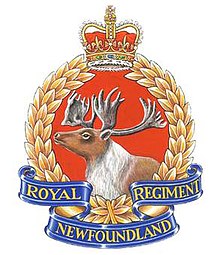
Back Royal Newfoundland Regiment German Royal Newfoundland Regiment French Royal Newfoundland Regiment NB
| Royal Newfoundland Regiment | |
|---|---|
 The badge of The Royal Newfoundland Regiment. | |
| Active | 1949–present 1939–1946 1914–1919 1803–1816 1795–1802 |
| Country | |
| Branch | Canadian Army |
| Type | Line Infantry |
| Role | Light Infantry |
| Size | Two Battalions |
| Part of | 5th Canadian Division |
| Garrison/HQ | RHQ – St. John's 1st Battalion – St. John's 2nd Battalion – HQ & A COY Corner Brook B COY – Grand Falls-Windsor C COY – Stephenville |
| Nickname(s) | The Blue Puttees |
| Motto(s) | Better than the Best |
| Colors | Scarlet and White |
| March | Quick – The Banks of Newfoundland Slow – The Garb of Old Gaul |
| Mascot(s) | Sable Chief - Newfoundland Dog |
| Anniversaries | ANZAC Day – 25 April Memorial Day – 1 July |
| Engagements | War of 1812 First World War Second World War War in Afghanistan |
| Battle honours |
|
| Commanders | |
| Current commander | 1st Bn: LCol Kyle Strong, MB, CD 2nd Bn: LCol Kyle Strong, MB, CD |
| Colonel-in-Chief | Anne, Princess Royal |
| Honorary Colonel | Joan Marie Aylward |
| Notable commanders | Lt. Col Thomas Skinner Lt. Gen John Skerrett Lt. Col Arthur Lovell Hadow Col James Forbes-Robertson Col. Joseph O'Driscoll |
The Royal Newfoundland Regiment (R NFLD R) is a Primary Reserve infantry regiment of the Canadian Army. It is part of the 5th Canadian Division's 37 Canadian Brigade Group.
Predecessor units trace their origins to 1795, and since 1949 Royal Newfoundland Regiment has been a unit of the Canadian Army. During the First World War the battalion-sized Newfoundland Regiment was the only North American unit to fight in the Gallipoli campaign of 1915. Later in the war the regiment was virtually wiped out at Beaumont Hamel on July 1, 1916, the first day of the Battle of the Somme, but was rebuilt and continued to serve throughout France and Belgium until the armistice, serving as part of the British Army of the Rhine in 1919. In December 1917, George V bestowed the regiment with the right to use the prefix "Royal" before its name. It was the only military unit to receive this honour during the First World War.
During the Second World War, the Newfoundland Militia was raised for defence and renamed the Newfoundland Regiment in 1943. The regiment remained in a home-defence role and also trained recruits for the two regiments of the Royal Artillery that were recruited in Newfoundland for overseas service. In 1949, Newfoundland joined Canada as the latter's 10th province and part of the Terms of Union required the re-creation of the Royal Newfoundland Regiment as the primary militia unit for the province. The regiment is ranked last in the Royal Canadian Infantry Corps' order of precedence.